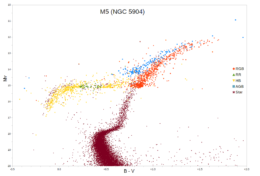The gas expelled by dying stars gets twisted into intricate shapes and patterns as nebulae form. Now a team of researchers might have some answers about how this happens.
What’s a Pre-Planetary Nebula?

This H-R diagram for the globular cluster M5 shows where AGB stars lie: they are represented by blue markers here. The AGB is one of the final stages in a low- to intermediate-mass star’s lifetime. [Lithopsian]
Instead, during this time the gas is relatively cool and dark, faintly reflecting light from the star and emitting only very dim infrared emission of its own. At this stage, the gas represents a pre-planetary nebula. Only later when the stellar core contracts enough to heat up and emit ionizing radiation does the nebula begin to properly glow, at which point it qualifies as a full planetary nebula.

Images of OH231 in optical light (top) and 12CO (bottom) taken from the literature. [See Balick et al. 2017 for full credit]
Unexpected Shapes
Pre-planetary nebulae are a very short-lived evolutionary stage, so we’ve observed only a few hundred of them — which has left many unanswered questions about these objects.
One particular mystery is that of their shapes: if these nebulae are formed by stars expelling their outer layers, we would naively expect them to be simple spherical shells — and yet we observe pre-planetary nebulae to have intricate shapes and patterns. How does the star create these asymmetric shapes? A team of scientists led by Bruce Balick (University of Washington, Seattle) has now used simulations to address this question.
Injecting Mass
Balick and collaborators use 3D hydrodynamic simulations to model one particular pre-planetary nebula, OH231, which lies ~4,200 light-years away and is about 1.4 light-years long. This is a well studied nebula, so the team had many observations that their model needed to successfully replicate: the nebula’s shapes, dimensions, overall geometry, locations of shocks, timescales, and even velocity gradients are known.
The authors’ model included mass injection from the central source into the ambient gas in three different ways:
- clumps: spherical knots injected all at once,
- cylindrical jets: thin outflows with parallel streamlines, and
- sprays: conical outflows with diverging streamlines.
Explanation from a Champagne Bottle

Panel A: best-fitting simulations of OH231 200, 400, and 800 yr after the clump and spray are launched. Panel B: example from the same family of solutions, in which the mass is reduced by a factor of 10. Click for a closer look. [Balick et al. 2017]
These simulations successfully map out all but perhaps the first century of the nebula’s evolution and give us some of the best insight yet into how these short-lived objects are formed. The authors are now working to reproduce these simulations for other pre-planetary nebulae, with the goal of piecing together common attributes of their ejection histories.
Citation
Bruce Balick et al 2017 ApJ 843 108. doi:10.3847/1538-4357/aa77f0


6 Comments
Pingback: making pre planetary nebulae
Pingback: La Formazione di una Nebulosa Preplanetaria | Accademia delle Stelle
Pingback: This Is What The ‘Last Gasp’ Of A Dying Sun-Like Star Looks Like - News Portal
Pingback: This Is What The ‘Last Gasp’ Of A Dying Sun-Like Star Looks Like -
Pingback: This Is What The ‘Last Gasp’ Of A Dying Sun-Like Star Looks Like - Latest News Post
Pingback: This Is What The ‘Last Gasp’ Of A Dying Sun-Like Star Looks Like - Science and Tech News